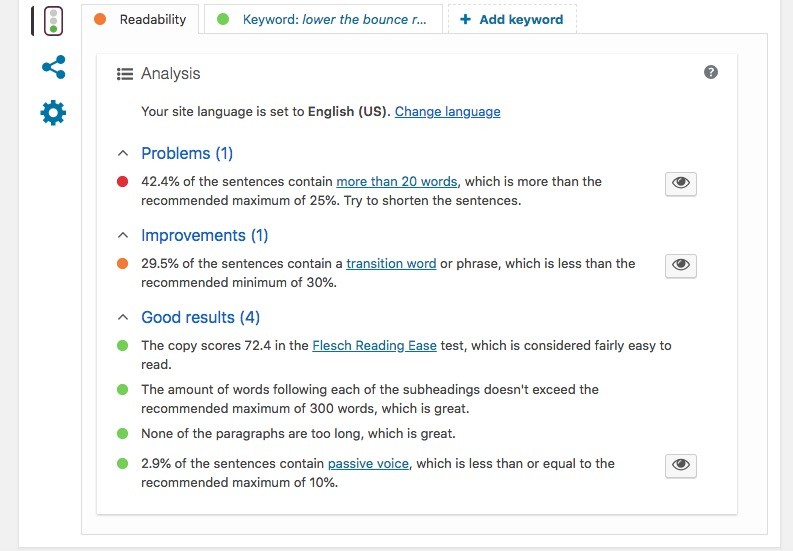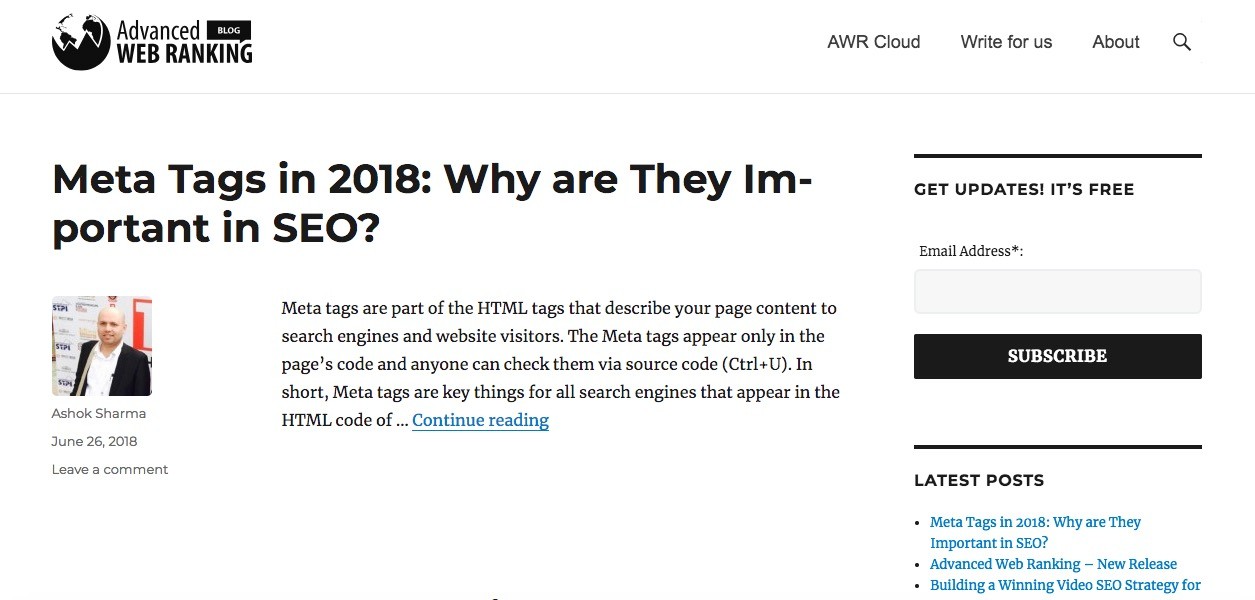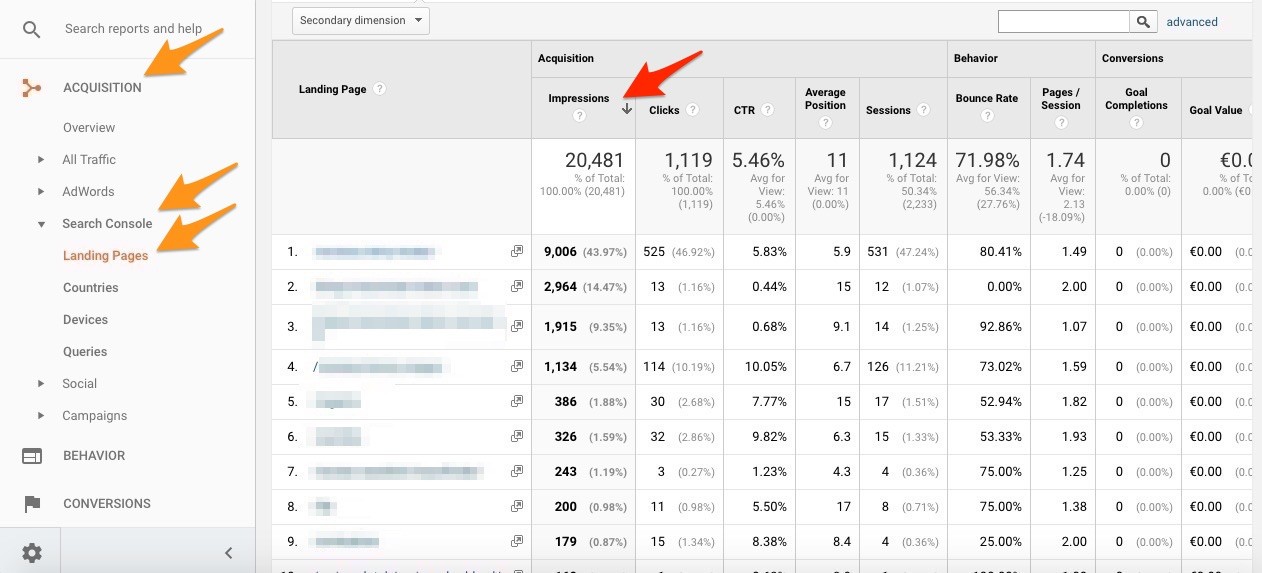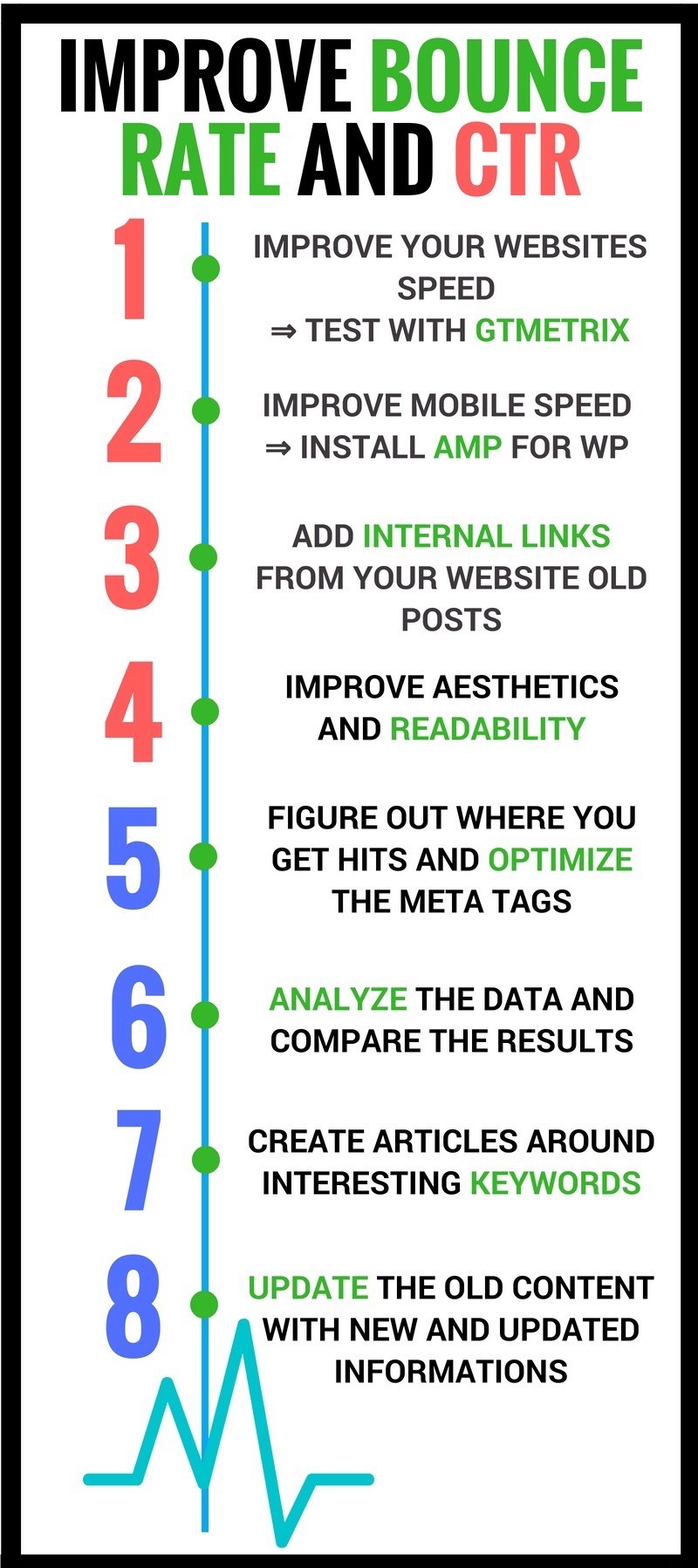
How to Lower the Bounce Rate & Increase the CTR to Boost Rankings
If you are able to lower the Bounce Rate and increase the organic CTR of your site, you send Google some very good signals.
Google loves nice content on websites - and there are no better signals than engaged users on a specific site.
The bounce rate doesn't have a direct effect on SEO, but indirectly it has a huge impact.
In fact, you will be able to escalate the Google ladder only if your site CTR on the SERP and Bounce Rate have good values.
What are the Bounce Rate and the CTR?
The Bounce Rate is a percentage that indicates the number of visitors that lands on your website without looking at other pages.
The lower the Bounce Rate, the better it is. For instance, a Bounce Rate of 90% means that 90% of the people visiting your site are not looking at any other pages. This is pretty bad.
The CTR is the percentage of people who click on your website title on the SERP compared to the Impressions.
The higher it is, the better it is. For instance, if your CTR is 90% it means that 90% of the people that see your website on the search results click on it and visit it.
You can easily figure out that these two entities are related!
In fact, it doesn't make any sense to have a super optimized website in the search results with the meta tags, title tags, etc... if the visitors going to your website bounce back to the SERP or are not visiting any other page on your site.
The ideal case is that you have super high CTR and very low Bounce Rate. This will tell Google that your website is the one to show in the first spot.
You can spot the precise numbers for these two metrics from Google Analytics and the Google Search Console.
But how to lower the Bounce Rate and increase the CTR then?
How to find your website's Bounce Rates and CTRs
The easiest way to find out your website's Bounce Rates and CTRs is via Google Analytics.
The real Bounce Rate applies only to new users - returning visitors need to be excluded from the analytics. To do this you need to add a segment.
You can follow the GIF below or simply add a new segment from the top bar and click on apply after you have checked 'new users'.
Log in into your Google Analytics and go to Audience ⇒ Overview ⇒ Look at 'Bounce Rate'

You can figure out the CTR of your website from Google Analytics too.
You need to go to Acquisition ⇒ Search Console ⇒ Landing Pages, but I find it easier to read it in Google Search Console.
Log into your Google Search Console and go to Search Traffic ⇒ Search Analytics ⇒ Check The Boxes On Top ⇒ Sort by Impressions ⇒ Look where your CTR is low for Impressions.
How to lower the Bounce Rate and increase the CTR | Steps to take
Technical SEO steps to take
If you are a WordPress user you can take action immediately, at least from the technical point of view of your website.
#1 - Website Speed
The first thing you want to ensure for your website is loading speed. You don't need to have a college degree to figure out that if a web page takes forever to load after you click on the search result, the user will bounce back.
If you are on WordPress, you can follow the step by step guide on the following link to increase website speed. I wrote this very long guide, but it will increase your website speed a lot and immediately.
You can test your website speed with tools like GTmetrix or Google Speed Insights. I prefer GTmetrix, because it's easy to scroll over all the errors and try to fix them all to reach a speed of at least 3 seconds or less.

#2 - Install AMP For WORDPRESS
Another thing you can immediately do is to install AMP for WordPress so that mobile users will have an accelerated version available for them.
AMP is an ambitious project from Google that aims to help people living in less advanced countries to have websites loading fast on their mobile phones.
AMP will transform web pages into a simpler code to read for their browsers on mobile so that they will load faster.
#3 - Add internal links
Next you want to add internal links to other pages of your blog. This increases the chance that users will click on them and hence visit another page on your site. As a result, your Bounce Rate will be more likely to lower.
Consider that the next step is what will make your visitors more engaged and likely to read your blog post.
You should focus on keeping that user on your website longer, so that the chances to click on other links are increasing as well - so the Bounce Rate drops.
#4 - Aesthetics and readability
Another thing you should do is to make your site more readable. You can use Yoast SEO on WordPress and make the readability check all green.

Try to include nice images, videos and multimedia files to entertain your visitors. Also, limit the use of ads and distracting things like pop-ups and any other annoyances as suggested by our friend Neil Patel as well.
Look how nice the Advanced Web Ranking blog homepage looks!

Analytic SEO steps to take
These are steps you can take, but the effect won't not be immediate and you don't have total control over them.
You need to arm yourself with patience and a clear mind to analyze data and optimize your site for the best.
#5 - Figure out the garbage pages and optimize the meta tags
Figure out which are the pages that get more hits and Impressions. Try to improve the meta tags and titles of your page.
To figure out the pages that get most of the clicks, you need to go to Google Analytics and click on Acquisitions ⇒ Search Console ⇒ Landing Pages ⇒ Sort by Impressions.

If you find meaningless pages that get 100% Bounce Rate and are thus useless for your site, just go ahead and delete them.
#6 - Analyze the data and compare from the previous results
Try to understand if your organic click through rate improves after the changes you made to your titles. If it does, look at the Bounce Rate of that specific page and see if it improved as well.
To see the Bounce Rate of a specific page you will need to go to Google Analytics and select the segment you have created before for the new users.
Acquisitions ⇒ Search Console ⇒ Landing Pages ⇒ Sort by Bounce Rate.

Once you are able to see the data, try to compare it with the previous months. You can change the timeline of Google Analytics from the top right of the website.
Compare the CTRs and Bounce Rates from the previous months, before applying the improvements or changes to your meta tags and content.
If you've managed to lower the Bounce Rate and raise the CTRs it means that you are on the right path - if not, you need another approach.
#7 - Create articles around interesting keywords
You need to create articles around interesting keywords (point 5 of the link) that might have some purchase or engagement intent.
For instance, creating an article around 'how to make sushi' might engage more people compared to 'is sushi easy to make'.
#8 - Update old content with fresh content
Update old blog posts with new information so that users landing on your page don't see sign-ups forms to Myspace or outdated websites.
It is proven that updating old content is better than rewriting new articles around the same keyword.
Brian Dean from Backlinko has mentioned this multiple times and I have proof as well that is the way to proceed.
Updating titles, meta tags and the content on your site will make Google very happy.
Conclusions
To lower the Bounce Rate on a website you can take steps that are technical in nature - some of them will have immediate results.
Some other steps you can take are analytical and will take longer to show. You will constantly need to analyze and figure out the numbers that show up in Google Analytics and Search Console.
I have tried to show you the best way to find these numbers and correct their values to your advantage.

If you know other and more effective ways to boost these values I would ask you to comment below and share your tricks with us.
So remember, something you should immediately take action on is improving your site speed, the meta and title tags, and figure out where you are getting more hits.
I also strongly advise you to host all your sites somewhere reliable and manage your NS server with a cool CDN like Cloudflare. This will improve the way Google sees your websites without a lot of effort.
Note: The opinions expressed in this article are the views of the author, and not necessarily the views of Caphyon, its staff, or its partners.
Article by
Marco Diversi
Marco Diversi is a super affiliate for many companies like CrakRevenue, Awempire, MaxBounty, Peerfly and many others. He started his career as a Civil Engineer graduated from the University of Miami, Florida, and then after trying many paths in life, he started to make serious money as an affiliate on the internet. He now started a blog on MarcoDiversi.com where he's teaching how to have success online with SEO and Affiliate Marketing.
stay in the loop





